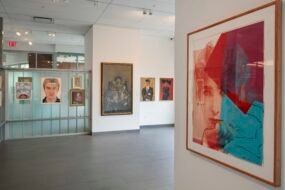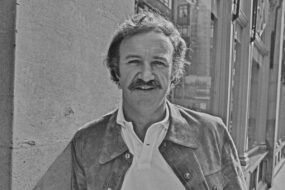The Ralph T. Coe Center for the Arts will relinquish its space on Pacheco Street and some of its remaining collection of Native art to the Institute of American Indian Arts by the end of the year.
The tribal college will use the two buildings to bolster its graduate program offerings, providing office, classroom and exhibition space for the college to establish a Master of Fine Arts campus in the midtown location.
The remaining art collection will be shared between that new campus and the college’s Rancho Viejo campus, according to a Monday news release from the college.
“ Essentially, we’re giving everything away. From our financial assets, to the campus — to the collection itself,” said Rachel Wixom, a niece of Ralph “Ted” Coe and head of the nonprofit center since its inception.
After the property transfers — and a $700,000 grant to maintain and upgrade the building — are finished by December, Wixom said, the nonprofit will dissolve.
The IAIA transfers are a capstone of the center’s rehoming initiative, a “final chapter” for the art collection. The center has transferred ownership of the pieces to their original communities and to institutions that prioritize cultural stewardship “rooted in respect, reciprocity, and responsibility,” according to a webpage from the Coe Center. The site includes a list of almost 50 institutions and Native groups that have received or are in the process of receiving art through the initiative — a list that includes several New Mexico pueblos and the Indian Pueblo Cultural Center in Albuquerque.
Those groups will also receive grants — the amounts of which will be determined in October, Wixom said, after the nonprofit reassesses its finances.
“We’re really excited to do that because in this day and age with money drying up … these grants will probably make a difference for these tribes and museum organizations,” she said, adding the center’s leaders felt strongly “we’re only representing these people, and they should have direct access.”
IAIA will also receive the remainder of the Native art collection “once all other rehoming is complete,” according to the college, which added that beyond the site’s primary planned use as a graduate student campus, it will also provide space for the Cinematic Arts and Technology program, artist residencies and a “teaching collection.”
New IAIA President Shelly Lowe said in the news release the “historic gift” will deepen the college’s impact in Santa Fe and across the world and that it “ensures that the Coe Center’s legacy will continue to thrive in service to future generations of Indigenous artists, scholars, and cultural leaders.”
‘Can’t take it with you’
Wixom said the return of Native art to the groups that produced it and the institutions that steward it was in line with her uncle’s mission to make the work more accessible, both to non-Indigenous communities unaware of its existence and Native communities who have been historically excluded from the high art of galleries and museums.
“They’re the experts. This is their heritage,” Wixom said. “And so we felt strongly at the Coe Center that we’re only representing these people and they should have direct access.”
Wixom said she was also burned out as the nonprofit’s longtime executive director, particularly given the “current climate” of nonprofits. In her talks with the Coe board in deciding a path forward, she “tried to channel [Coe] and what his perspective was,” she said. She also looked to the message of the mural on the exterior of the center — a piece titled You can’t take it with you … so give it all away, painted in 2021 by Nanibah “Nani” Chacon, a Diné and Chicana artist.
Nanibah Chacon, right, of Albuquerque paints a mural commissioned by the Ralph T. Coe Center for the Arts at its annex on Pacheco Street in 2021. The mural depicts two Indigenous women holding baskets from the Coe collection.
Wixom and the board picked IAIA as the collection’s steward, partly, she said, because of its history fostering Native art and experience maintaining buildings.
“We just felt it was a good fit and what a win-win for that organization — and for the city of Santa Fe, who I really hope supports this,” said Wixom, noting the property transfer could be a boon for the midtown area, which is also undergoing a major redevelopment by the city.
Foundation history
Wixom was serving as head of publications for the Whitney Museum of American Art in Manhattan when she received a call from her uncle in 2007. Aware of his declining health and afflicted with Alzheimer’s disease, he requested she be the one to take stewardship of his organization upon his death.
Though Coe laid the foundation for the nonprofit, it began formally operating with Wixom at the head upon Coe’s death three years later in 2010, moving into its home on Pacheco Street in 2014.
“I was encouraged to bring it to New York,” Wixom said of the collection, “but New York was certainly not ready for this kind of approach to the arts.”
Coe, too, had considered moving the collection to New York — specifically the Metropolitan Museum of Art, which has about 40 of Coe’s pieces of Native art. But Wixom said her uncle believed “they weren’t far enough along in their thinking,” and the work would “disappear into their storage areas.”
Coe was a lifelong curator and collector. He had first served in multiple positions curating and directing shows from the National Gallery of Art to the The Nelson-Atkins Museum of Art in Kansas City, Mo. His love for Native art, which began as a student in the 1950s, came to fruition decades later when he traveled through North America to learn from Native artisans and glean insight from their techniques.
His second major exhibit — Lost and Found Traditions: Native American Art, 1965-1985 — was the first major exhibition of contemporary Native art, which began in 1986 and showed across 10 museums, according to Coe’s New York Times obituary.
“Collecting wasn’t about collecting trophies and having bragging rights,” said Wixom of her uncle’s approach. “It was about understanding the human condition and the world in which we live in.”









